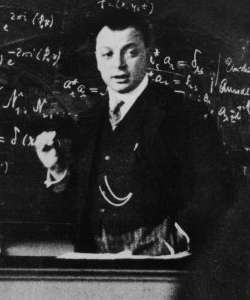Pauli Exclusion Principle in chemistry allows us to understand the electron arrangements in atoms and molecules and thus gives an explanation for the classification of elements in the modern periodic table.
This principle was formulated in 1925, by an Austrian physicist, Wolfgang Pauli.

Index
The Principle
The principle is stated as follows:
In a single atom, no two electrons will have an identical set or the same quantum numbers.
In other words, every electron must have its own unique state.
The Pauli exclusion principle, however, does not apply to only electrons, but also to fermions, or particles with half-integer spin.
An Example
Let us take a neutral nobel gas, helium atom. A helium atom has 2 bound electrons and they occupy the outermost shell with opposite spins.
Each electron has n = 1, l = 0, ml = 0.
The spin moment of each electron is different. One electron has ms = -½ and the other has ms = ½.
Applications
- The Pauli exclusion principle is used to describe the electronic configuration of chemical elements, and how they participate in chemical bonding.
- This principle is also used in defining the modern periodic table.
- Apart from chemistry, Pauli Exclusion Principle is a fundamental principle in quantum mechanics.
- It is also used in astrophysics.
FAQs
Quantum numbers are the values that describe the state of an electron.
This includes the following:
n – Principle quantum number; talks about position of electrons in shells.
l – Orbital angular momentum; determines the shape of the orbital.
ml – Magnetic quantum number; reveals the number of orbitals and their orientation.
ms – Spin quantum number; identifies the direction of the electron spin.
The principle states that no two electrons in the same atom can have identical values for all quantum numbers.
Related Topics:
